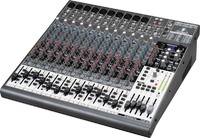![]() Attention, did you notice that this article is not called "Stereo Sound Mixing for Film/Video." That is because just about everything that you record on the set will be monaural, even though the headphones, mixer, and recorder all use the term stereo.
Attention, did you notice that this article is not called "Stereo Sound Mixing for Film/Video." That is because just about everything that you record on the set will be monaural, even though the headphones, mixer, and recorder all use the term stereo.
You may have two (or more) recording tracks, but what you will be recording is two (or more) monaural tracks, not a "stereo" track.
The term stereo refers to capturing the left side and right side components of a sound, so that when they are reproduced out of a pair of left side and right side speakers, or headphones -- the listener will have a sense of left and right balance or space. Sounds may originate on the left or right of the listener, and may even travel ("pan") across from one side to the other, or just park somewhere in between hard left and hard right.
Stereo is what happens when we listen to music, or a fully mixed movie. It is the finished result for the enjoyment of the audience.
But stereo is rarely recorded as such in the field. Instead, we record monaural sounds and wait until post-production is nearly complete to re-assign these sounds to the audience's left, right, and in-between.
Until the film is edited, there is no way to know just where all of the audio elements need to end up. For instance, out on production, it might seem logical to record a car that passes from left to right in stereo, so that you can hear the "pass by" in your phones whoosh from the left ear to the right ear.
 If the movie only consisted of that one angle of the car, with no intercuts, then your stereo track would be quite usable. However, in the real world, that car-by is likely to be covered from a multitude of camera angles, and then intercut with a multitude of close-ups and insert shots. Many (if not most) of this additional footage will represent screen center (as opposed to the wide shot of the car travelling from screen left to screen right).
If the movie only consisted of that one angle of the car, with no intercuts, then your stereo track would be quite usable. However, in the real world, that car-by is likely to be covered from a multitude of camera angles, and then intercut with a multitude of close-ups and insert shots. Many (if not most) of this additional footage will represent screen center (as opposed to the wide shot of the car travelling from screen left to screen right).
As the finished sequence is built by the editor, it might start with a long shot of a car coming towards the screen, some left to right angles, maybe some more dead-on angles, some shots of the driver, inserts of gas pedals, shifter knobs, angles on the passenger, sheriff's car lurking, woman with baby carriage about to cross the street, and….
You can see where this is going; it is certainly not a simple pan the sound from left to right situation. The editor would not want the audio to ping pong rapidly from screen left, to center, to left, to right, back to center, etc. The flow of the audio has to be paced with the changing perspectives of the shots; with full audio pans carefully and strategically employed for full effect, but not as meaningless distraction!
The solution is to record all of the sounds as monaural (center screen); and to let the editors re-mix and re-assign those sounds to various surround positions during post-production. Also, keep in mind that professional films are not two-track stereo presentations, but are at the least, surround sound six-track (aka 5.1 surround). Audio has to be positioned amongst screen left, screen center, screen right, surround rear left, surround rear right, and sub-woofer effect!
Therefore, if we are recording in two-track in the field, we do not think in terms of left track and right track. Instead, rename these connectors (in your head) as Track One and Track Two. You have two places to store the recorded audio; and the audio in these two places should be different, so that the editor has maximum flexibility to select/adjust one track over the other.
Professional mixing panels intended for film/video applications often lack variable pan settings. Instead of a rotary knob, the operator is given a three-position sliding switch (track 1, track 2, or both/mono). There is no such thing as "panning" a mic so that it is somewhere in-between!
If your mixer has a fully variable pan pot, then get into the habit of assigning each input to either the full left or full right positions. Never allow an input to "straddle" both tracks, since it would make it impossible for the editor to make independent adjustments.
